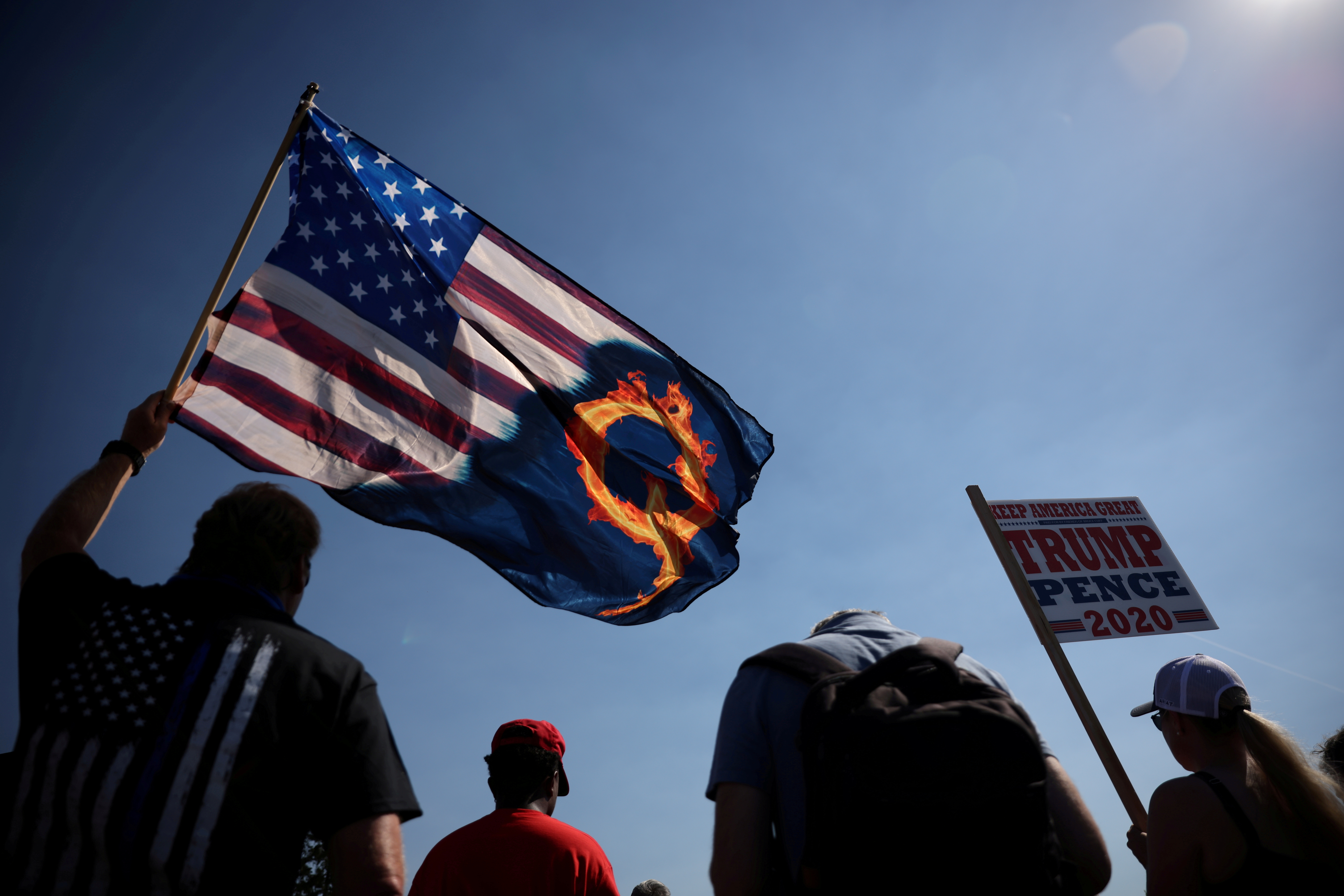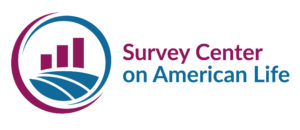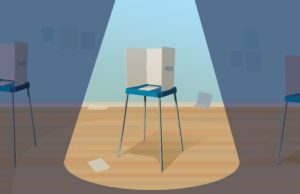October 13, 2020
Conspiracy Theories, Misinformation, COVID-19, and the 2020 Election
Findings from the September 2020 American Perspectives Survey

The survey was conducted by the Survey Center on American Life in collaboration with the Center for American Progress.


KEY POINTS
Democrats and Republicans both believe in conspiracy theories, but different ones.
- Sixty percent of Democrats believe Russia has damaging information about Donald Trump, a belief shared by only one in three Americans overall.
- A majority (59 percent) of Republicans are convinced that there has been a coordinated effort by “unelected government officials” to undermine the Trump administration.
Roughly four in 10 Americans are familiar with the QAnon conspiracy theory, and only 16 percent of Americans who have heard or read at least a little about these conspiracies say they are accurate.
Despite the widespread coverage of the anti-vaxxer movement, very few American believe that vaccines are responsible for autism. Ten percent of Americans say the statement “childhood vaccines have been shown to cause autism” is mostly or completely accurate.
Republicans are more likely than Democrats to embrace inaccurate information about COVID-19.
- Close to half (48 percent) of Republicans, compared to 25 percent of Democrats, say COVID-19 is no more serious than the common flu. Republicans are also more likely to believe that “Hydroxychloroquine is a safe and effective way to treat COVID-19,” (42 percent vs. 5 percent).
Less than half of Americans, and only one in five black Americans, say they would get a free FDA-approved vaccine for COVID-19.
- Americans are reticent to get a COVID-19 vaccine because of concerns about its safety. Among those who would not get a vaccine, nearly two-thirds (65 percent) say concerns about safety is the primary reason.
Many American are worried about the potential coziness of political reporters to their subjects.
- Nearly half (47 percent) of Americans overall agree that, “most journalists who cover politics and politicians are too friendly with the people they cover.” Half (50 percent) of the public disagrees.
The 2020 Election and Voting Concerns
One month from the election, Joe Biden leads Donald Trump by a sizable margin among registered voters. Fifty percent of Americans who are registered to vote plan to vote for Biden in the fall election, and 40 percent say they will vote for President Trump, with 4 percent backing another candidate and 5 percent planning not to vote this cycle.
Partisan commitments are solid but not fully consolidated at this stage, with 92 percent of Democrats planning to back Biden and 87 percent of Republicans planning to support the president. A relatively small, but perhaps important, percentage of partisan defections are possible and currently favor the former vice president: Six percent of Republicans plan to vote for Biden, compared to 4 percent of Democrats who plan to vote for Trump. A plurality of independents break for Biden over Trump by a 48 percent to 32 percent margin, with 17 percent looking at another candidate or not planning to vote in this election.
Confidence in the National Election
Despite criticisms of mail-in voting and the balloting process, most Americans have confidence in how the election will be administered. The study finds six in 10 (60 percent) Americans say the US election this November will be run and administered very well or somewhat well versus 39 percent who believe it will be run either not too well or not at all well.
Although Americans are relatively united in their overall confidence in the voting process, the specter of potential voter fraud—particularly regarding mail-in voting—emerges as a highly divisive issue highlighting major partisan differences.
Americans are divided over whether “an increase in voting by mail in 2020 will lead to widespread fraud.” Slightly less than half (45 percent) of Americans agree that mail-in voting will lead to widespread fraud, while 53 percent disagree with this proposition. Partisans express nearly inverse positions on this question. Nearly eight in 10 (77 percent) Republicans agree that increased mail-in voting will lead to widespread fraud versus 79 percent of Democrats who disagree with this notion, along with more than half (54 percent) of independents.
Americans are more evenly divided over whether voting fraud has undermined recent election results. Nearly half (48 percent) the public says voting fraud has undercut the validity of recent US elections. Half (50 percent) of Americans disagree.
The partisan gap in views about the prevalence of voter fraud in recent elections is narrower than views about the potential problem posed by voting through the mail. Republicans are more likely than Democrats are to agree that “voter fraud across the US has undermined the results of our elections” (59 percent vs. 40 percent, respectively).
Americans with lower levels of formal education express greater concern about the specter of electoral fraud in recent elections. Nearly six in 10 (59 percent) Americans with a high school education or less agree that voter fraud has undermined election results, compared to 35 percent of college graduates and less than one-third (29 percent) of postgraduates.
News Consumption, Media Mistrust, and the Public Interest
Americans express markedly skeptical views about many sources of news and political information available today and instead report greater comfort with doing their own research and examination of multiple sources to decide on important issues.
Few Americans believe journalists are evenhanded when reporting on competing sides of an issue or debate. Three-quarters (75 percent) of Americans overall say news outlets reporting on politics or current events generally favor one side over another, compared to roughly one-quarter (24 percent) who feel these outlets provide fair and accurate accounts of each side.
Concern about the impartiality and balance of news sources crosses party lines, with independents and Republicans expressing the greatest skepticism. More than half (54 percent) of Democrats, compared to large majorities of independents (79 percent) and Republicans (91 percent), believe that most news outlets favor one side as opposed to providing balanced coverage.
A substantial number of Americans are worried about the potential coziness of political journalists to their subjects. Nearly half (47 percent) of Americans overall agree that “most journalists who cover politics and politicians are too friendly with the people they cover.” Half (50 percent) the public disagrees.
Views about political journalists’ tendency to maintain proper distances from their subjects also vary along partisan lines. Republicans (56 percent) express greater agreement than Democrats (39 percent) and independents (48 percent) do that journalists who cover politics and politicians are too friendly with their subjects.
Given these negative views of journalists and news outlets, Americans appear ready to turn to their own research as a source of information about current events rather than the stories the media presents. For example, approximately two-thirds of Americans overall agree that “you can learn more about what is going on in the world by ignoring mainstream news and doing your own research,” while around three in 10 (31 percent) disagree.
Partisan differences are pronounced, with Democrats split on mainstream media’s reliability over personal sleuthing. Half (50 percent) of Democrats agree that conducting your own research is a better way to learn the facts, while 49 percent disagree. Republicans overwhelmingly side against mainstream news as a source of information in favor of doing their own research (85 percent vs. 15 percent).
The public’s mistrust of news outlets is also evident in their feelings about the necessity to triangulate among multiple sources to get the complete story. More than eight in 10 (81 percent) Americans say the best way to get accurate information from the news is to rely on several different outlets.
Democrats and Republicans basically agree with the idea that “the best way to get an accurate picture about what is going on in the country is to rely on several different media sources.” Eighty-six percent of Democrats agree with this approach, along with 78 percent of Republicans and 79 percent of independents.
Public Trust in Specific News Outlets Higher Than General Trust in the Media
Despite overall skepticism about some mainstream news sources, when presented with a list of specific print, broadcast, cable, radio, and online news, public trust is generally high for several major news outlets. Majorities of Americans trust leading print outlets, such as the Wall Street Journal (59 percent), the New York Times (54 percent), and USA Today (54 percent), and legacy broadcasts, such as ABC, CBS, and NBC (58 percent), for information on politics and the election.
Half the public report they trust the Washington Post (50 percent) and CNN (50 percent), while NPR and Fox News Channel are trusted by about four in 10 people (39 percent and 40 percent, respectively). In contrast, more conservative news sources, such as Breitbart News Network and One America News Network, and more liberal ones, such as Vox, are unknown by large majorities of Americans and subsequently receive low levels of trust.
The pattern of partisan trust in specific media outlets reflects the greater mistrust Republicans express for news organizations more broadly. For example, more than eight in 10 Democrats say they trust news about politics from mainstream national outlets, such as the New York Times (83 percent) and ABC, CBS, and NBC (84 percent),compared to less than one-third of Republicans (23 percent and 30 percent, respectively). In contrast, Fox News Channel and the Rush Limbaugh Show are the only two media sources trusted by a majority of Republicans, while only one-fifth of Democrats (21 percent) trust Fox and 4 percent trust Rush Limbaugh. Interestingly, more than seven in 10 Democrats (72 percent) say they trust the Wall Street Journal, despite the publication’s conservative editorial tilt, while less than half (47 percent) of Republicans say the same.
Do Government, Large Corporations, and Media Hide Relevant Information from the Public?
Much of the American public is suspicious about the tendency of large public and private institutions to withhold information essential to public health and welfare. At least four in 10 Americans believe each major institution “often” withholds relevant health and other information from the public, while a majority of the public believes this occurs at least sometimes.
The federal government and drug companies emerge as the least trusted institutions in withholding essential information important to public health or welfare. Nearly half of Americans say they believe the federal government (48 percent) and drug companies (47 percent) often refuse to release information important for public health or welfare. About four in 10 Americans say technology companies such as Google, Facebook, and Amazon (40 percent); oil, gas, and coal companies (39 percent); and major news organizations (39 percent) purposefully withhold relevant health information from the public.
The degree to which Americans believe major industries, the government, and the media are hiding information varies between Democrats and Republicans. Democrats are more likely than Republicans are to say the federal government (53 percent vs. 42 percent) and oil, gas, and coal companies (49 percent vs. 24 percent) often refuse to release health or other information relevant to public welfare. Conversely, Republicans are more likely than Democrats are to say major media outlets (60 percent vs. 19 percent) and major technology companies (53 percent vs. 29 percent) frequently refuse to produce information crucial to public health and welfare.
Prevalence of Conspiracy Theories and Misinformation Among the Public
The September 2020 American Perspectives Survey tested various existing conspiracy theories about politics and public health to ascertain overall support for these ideas and examine whether demographic or partisan backgrounds are associated with greater propensity to accept or reject certain theories.
For each case presented in the survey, there is no existing confirmed and corroborated evidence that the claim is accurate. Americans were asked to weigh the accuracy of statements that are demonstrably false or lacking any supporting evidence: Barack Obama is an American citizen born in Hawaii, not Kenya; the George W. Bush administration was not in on the 9/11 attacks by al Qaeda; there was not widespread election fraud in the 2016 election; China did not manufacture COVID-19 in a lab and distribute it as part of a bioweapons program; coronavirus is not like the common flu; and there is no evidence an organized group of bureaucrats has been surreptitiously working against the Trump administration and similarly no evidence Vladimir Putin possesses compromising information about President Trump.
Given the nature of conspiracies, many believers of them will not accept facts that contradict their own beliefs. Likewise, conspiracists of all kinds often argue that the facts themselves are manufactured, thus proving the conspiracy’s underlying truth. This study cannot resolve these issues and was not designed to change people’s minds or challenge their views. Rather, the goal is merely to measure the penetration of these false claims among the American public.
Political Conspiracy Theories
Some conspiracy theories are designed to undermine the legitimacy or authority of particular political figures. These political conspiracy theories generally appeal to part of one political party’s base and are strongly resisted or rejected by members of the opposing party. In some instances, political leaders play a role in perpetuating a conspiracy theory for personal or political gains.
Voter Fraud in the 2016 Election
Shortly after Trump won the 2016 presidential election, he made an unfounded assertion that he not only captured enough votes to win the Electoral College but also won the popular vote, despite Hillary Clinton’s confirmed 2.87 million vote advantage. Trump alleged massive voter fraud cost him at least three million votes. Despite lacking evidence, Trump has repeated this claim in various forms on multiple occasions. As of this date, there is no evidence to support it.
Among the public, the claim of widespread voter fraud in the 2016 election receives little support. Only one-quarter (25 percent) of Americans say the claim of widespread voter fraud is mostly or completely accurate, while nearly half (49 percent) say it is inaccurate. One in four (25 percent) Americans express uncertainty about the issue of voter fraud in the 2016 election.
Although Republicans have more consistently expressed concern about the issue of voter fraud in past national elections, Democrats are more likely than Republicans are to believe the claim that there was widespread voter fraud in the 2016 election. More than one-third (34 percent) of Democrats, compared to 22 percent of Republicans, say it is mostly or completely accurate that the 2016 election featured extensive voter fraud.
The Deep State
From the earliest days of the Trump presidency, key administration members expressed distrust about the political motivations of career civil servants, particularly in parts of the intelligence community. After Special Counsel Robert Mueller was assigned to conduct an investigation into the role of Russian interference in the 2016 election, Trump suggested there was a coordinated effort across various federal departments and agencies to undermine his administration. Trump and his allies have made this claim repeatedly since then.
Overall, most Americans are not widely convinced there has been a coordinated effort by “unelected government officials” to undercut the Trump administration. Twenty-nine percent of Americans believe that the “deep state” has sought to undermine Trump and his administration. A roughly equal number (33 percent) of Americans reject this claim as lacking validity. Thirty-seven percent report being uncertain about its accuracy.
There are pronounced partisan divisions in views about the existence of the deep state. Nearly six in 10 (59 percent) Republicans believe it is accurate that unelected government officials are working together to thwart the Trump administration. Only 10 percent of Democrats share this belief. A majority (54 percent) of Democrats say this is not accurate, but 36 percent report being uncertain about the existence of the deep state working to undermine the Trump administration.
The Trump-Russia Connection
Several political commentators have noted Trump has cultivated a warm relationship with Russian President Vladimir Putin. Trump’s welcoming posture toward Putin and his complicated business history in Russia, viewed by many Republicans and Democrats as a key geopolitical foe, led critics of the administration to speculate whether the Russian president had potentially compromising information about Trump. Several former intelligence officials and media figures have advanced this unsubstantiated claim.
The claim that the Russian president has damaging information about Trump is not widely accepted by the public. Approximately one-third (34 percent) of Americans say the assertion that Putin has damaging information about Trump is mostly or completely accurate, while roughly as many (28 percent) say this is inaccurate. Thirty-seven percent of Americans say they are unsure about the claim.
That Russia has potentially damaging information about Trump has received much greater traction among Democrats than Republicans. Sixty percent of Democrats believe Russia has damaging information about Trump, a belief shared by only 10 percent of Republicans. Only 8 percent of Democrats say the claim is mostly or completely inaccurate, while 31 percent say they are not sure. Notably, while 56 percent of Republicans challenge the accuracy of the claim that Putin possesses damaging information about Trump, approximately one-third (34 percent) remain uncertain.
Birtherism
Former President Barack Obama’s unique personal history, his multiracial parentage as the son of a white Kansan-born mother and black father from Kenya, his formative years in Hawaii, and his distinctive name led some political opponents to seek personal or political advantage by raising questions about whether Obama was born in the US. This unfounded assertion was made by some supporters of his onetime Democratic-primary opponent, Hillary Clinton, and more recently by President Trump. In 2011, Obama released his long-form birth certificate proving his birthplace in Honolulu, Hawaii, but that has not stopped some prominent figures from publicly questioning his birthplace.
Few Americans believe there is any truth to the claim that Obama was born outside the US. Only 15 percent of Americans say the statement “there is evidence that shows Barack Obama was born outside the US” is mostly or completely accurate. A majority (57 percent) of the public say this statement is not accurate. Twenty-seven percent of Americans say they are not certain about the statement’s accuracy.
Democrats overwhelmingly reject the assertion that Obama was born outside the US, but relatively few Republicans do. Only 6 percent of Democrats believe it is accurate that evidence shows Obama was born somewhere other than the US. Seventy-nine percent say this claim is inaccurate. More than one-third (34 percent) of Republicans believe there is evidence demonstrating Obama was not born in the US, while approximately as many (32 percent) say this is not accurate. About one in three (34 percent) Republicans report being uncertain about the accuracy of the claim that Obama was born outside the US.
The September 11 Truth Movement
The September 11 terrorist attacks that resulted in more than 3,000 American deaths and untold economic devastation spawned various conspiracy theories, but many center on the federal government’s passive or active involvement in the event. One strand speculates key government personnel were aware of the attacks ahead of time but sought to use them as justification for launching an invasion of Iraq. Although the CIA had general information of an impending al Qaeda operation, there is no evidence any member of the Bush administration had advance warning of the actual attacks.
Relatively few Americans believe in the accuracy of the claim that senior officials in the Bush administration had advance notice of the September 11 attacks but refused to act because of a desire to begin military operations in Iraq. Seventeen percent of the public say this statement is mostly or completely accurate. More than half (51 percent) say it is not accurate, while about one-third (32 percent) report being uncertain about it.
Despite sharp political differences in views about various unproven claims and conspiracies, Democrats and Republicans share similar perspectives on this controversy. Only 19 percent of Democrats and 14 percent of Republicans believe there is any validity to the claim that the Bush administration had foreknowledge of the September 11 attacks.
QAnon
Unlike other conspiracy theories that focus on specific events, groups, or actors, QAnon is a loose collection of conspiracy theories that originated on online message boards. Although initially a fringe movement, it has attracted growing support partly by attaching itself to other causes, such as the anti-vaccine and anti-child-trafficking movements, and incorporating other well-known conspiracy theories, such as the September 11 truth conspiracy. Followers of QAnon have migrated offline, turning up at political rallies for right-leaning candidates while others have engaged in criminal activity. A recent internal document from the FBI that warned about the growing threat of “conspiracy theory-driven domestic extremists” specifically mentioned QAnon.
Despite the considerable amount of news coverage devoted to QAnon and the activities of its followers, many Americans report being unfamiliar with the conspiracy theory. More than six in 10 (61 percent) Americans say they have not heard or read anything about QAnon. About one-third (32 percent) of Americans report having a little familiarity with the conspiracy, while only 7 percent report having heard or read a lot about it.
Even though many QAnon supporters have greater sympathies for right-leaning politicians and public figures, Republicans are far less likely than Democrats are to have heard about QAnon. Nearly half (49 percent) of Democrats report having heard or read about QAnon, compared to 29 percent of Republicans.
Among those familiar with QAnon, few believe its claims are accurate. Only 16 percent of Americans who have heard or read at least a little about the conspiracy theory say the “information shared by QAnon has generally been shown to be accurate.” Eighty percent of those familiar with QAnon say its claims or theories are not accurate.
Overall, few Republicans or Democrats believe the information QAnon promotes is reliable or accurate. Only 4 percent of Democrats and 10 percent of Republicans say QAnon is a source of accurate information. However, among those who report being at least slightly familiar with QAnon, the partisan gap in views is significantly larger. More than one-third (35 percent) of Republicans who report having heard at least a little about QAnon say the claims made by the group are accurate. Only 8 percent of Democrats who have heard about QAnon say the same.
Scientific and Medical Conspiracy Theories and Misinformation
There is a long history of conspiracy theories on issues related to scientific or medical knowledge. One reason for the prevalence of medical or scientific conspiracy theories is that this type of information is often complex, requiring specialized knowledge to fully understand. Scientific evidence also contains some amount of uncertainty. In the face of complex or seemingly contradictory information, conspiracy theories may offer a compelling alternative.
The Anti-Vaxxer Movement
In 1998, a study published in Lancet, a reputable medical journal, found an association between autism and the MMR vaccine, administered to prevent measles, mumps, and rubella. Since then, several peer-reviewed studies, including a 2013 Centers for Disease Control and Prevention study, found vaccines do not cause autism. However, rising rates of autism diagnoses fueled concerns about whether childhood vaccines cause autism. Prominent public figures, such as the actress Jenny McCarthy, have become passionate spokespersons in opposition of vaccinations.
Despite the widespread coverage of the anti-vaxxer movement, few Americans believe that vaccines are responsible for autism. Ten percent of Americans say the statement “childhood vaccines have been shown to cause autism” is mostly or completely accurate. Two-thirds (67 percent) of Americans say the claim is inaccurate, including nearly half (45 percent) who say it is completely inaccurate.
Across the demographic divide—gender, education, age, and political affiliation—few Americans embrace the link between childhood vaccinations and autism. However, white Americans are more likely to reject the claim. More than seven in 10 (72 percent) white Americans say the assertion that autism is caused by vaccines is mostly or completely inaccurate, while fewer Hispanic (58 percent) and black Americans (46 percent) say the same. Notably, although black Americans are not more likely to say the claim is accurate, they are more likely than Hispanic and white Americans are to express uncertainty about it (41 percent vs. 31 percent and 19 percent, respectively).
Anti–Genetically Modified Organism Movement
A growing number of food producers in the US rely on genetically modified crops to increase efficiency and yield size by making them more resistant to disease, pests, and extreme weather conditions. In response, many environmentalists and public interest groups have raised concerns about the potential health and environmental effects and have moved to require mandatory labeling of genetically modified foods.
Despite these efforts, a group of national and international health and medical organizations, including the World Health Organization, the National Academy of Sciences, and the American Medical Association, have affirmed that genetically modified organisms (GMOs) do not present any threat to human health. A 2016 report from the National Academy of Sciences, Engineering, and Medicine concluded GMOs are safe. But the widespread usage of GMOs, particularly in processed foods, has continued to cause concern about their health impact.
More than one in three (36 percent) Americans believe agribusinesses are promoting genetically modified foods despite evidence that they harm human health. Less than one-third (31 percent) of the public says this claim is inaccurate; an equal number (31 percent) expresses uncertainty about it.
There are modest differences in the beliefs of women and men. Overall, women are somewhat more likely than men are to believe GMOs harm human health (39 percent vs. 33 percent). However, the gender gap widens among those with more years of formal education. Four in 10 (40 percent) women with a postgraduate level of education believe corporations are promoting GMOs they know to be harmful, compared to 24 percent of men with postgraduate degrees.
COVID-19 as a Biological Weapon
Early in the COVID-19 pandemic, there were assertions that the disease, which originated in China, was designed as part of a biological weapons program. This claim began partly because of an advanced virology lab in Wuhan where the COVID-19 pandemic first appeared. The ongoing economic and diplomatic tensions between China and the US further fueled speculation about the origin of COVID-19 and whether it could have been developed purposefully as part of a weapons program. However, there is no evidence to support this claim.
Most Americans reject the claim that COVID-19 was part of a Chinese biological weapons program. Only 22 percent of Americans say this claim is accurate. Notably, less than half (49 percent) of Americans reject this assertion outright. More than one in four (28 percent) say they are uncertain as to whether COVID-19 was developed by China as part of a biological weapons program.
Republicans are four times more likely than Democrats are to believe COVID-19 was designed in a lab as part of a Chinese biological weapons program. Four in 10 (40 percent) Republicans say it is mostly or completely accurate that COVID-19 was intentionally developed in a Chinese lab, while only 10 percent of Democrats believe in the accuracy of this claim. Roughly two-thirds (67 percent) of Democrats and one-third (34 percent) of Republicans do not believe this claim is accurate. Roughly one-quarter of Democrats (23 percent) and Republicans (26 percent) report they are not sure about the claim that COVID-19 was developed in a lab as part of a weapons program.
Public Misperceptions About COVID-19
Public attitudes and knowledge about COVID-19 have shifted over the year as medical and public health professionals learn more about the virus. Furthermore, inconsistent and sometimes inaccurate communications from the federal government have also resulted in misperceptions about the nature and seriousness of the pandemic. But these misperceptions are more common among certain segments of the public.
Although medical professionals have consistently argued COVID-19 presents a greater health threat than the seasonal flu does, a significant number of Americans believe the virus is not any more serious. One-third (33 percent) of Americans believe COVID-19 is not any more serious than the common flu. About six in 10 (58 percent) Americans say this is not accurate. Eight percent report being uncertain about this statement.
In the US, there are sharp political divisions in perceptions about the danger COVID-19 poses. Close to half (48 percent) of Republicans, compared to 25 percent of Democrats, believe in the accuracy of the statement that COVID-19 is no more serious than the common flu. Seventy percent of Democrats challenge the accuracy of this assertion, including 62 percent who say it is completely inaccurate.
Few Americans believe that hydroxychloroquine, also known as chloroquine, safely and effectively treats COVID-19. Less than one in five (19 percent) Americans say this claim is mostly or completely accurate. Close to half (49 percent) say it is not accurate. Nearly one in three (30 percent) Americans say they are not certain of the statement’s accuracy.
There is also a considerable partisan disparity in views about the efficacy of hydroxychloroquine as a treatment for COVID-19. More than four in 10 (42 percent) Republicans and only 5 percent of Democrats believe the statement “Hydroxychloroquine is a safe and effective way to treat COVID-19” is mostly or completely accurate. Nearly three-quarters (73 percent) of Democrats and 27 percent of Republicans say this claim is not accurate.
Overall, roughly equal numbers of Americans believe the reported COVID-19 deaths by the news is undercounting as overcounting. Thirty-eight percent of Americans say more people have died of COVID-19 than has been reported by the news, while nearly as many (35 percent) say the news reports have inflated the actual number of fatalities. About one-quarter (26 percent) of Americans say the news reports of COVID-19-related deaths are accurate.
With perceptions of mortality, there are also stark political differences, with Democrats and Republicans reporting near mirror-image views. Nearly six in 10 (59 percent) Democrats believe more people have died from COVID-19 than has been popularly reported by the news. More than six in 10 (63 percent) Republicans say news reports of COVID-19 deaths have been inflated.
A COVID-19 Vaccine
Less than half (44 percent) of Americans report they would be willing to get a no-cost, FDA-approved vaccine to prevent COVID-19. A majority (54 percent) of the public say they would not agree to be vaccinated.
Across the political spectrum, interest in receiving a vaccine for COVID-19 is fairly tepid. Less than half of Democrats (47 percent) and Republicans (45 percent) say they would get an FDA-approved vaccine for COVID-19.
There is a massive racial disparity in willingness to receive a COVID-19 vaccine. Nearly half of white (48 percent) and Hispanic (48 percent) Americans say they would take an FDA-approved vaccine to prevent COVID-19 if it was offered at no cost. But only 21 percent of black Americans report they would take it.
Men report being much more willing to take a vaccine than women report. More than half (51 percent) of men and less than four in 10 (38 percent) women say they would take an FDA-approved vaccine.
By far, Americans are reticent to get a COVID-19 vaccine because of safety concerns. Among those who would not get a vaccine, nearly two-thirds (65 percent) cite safety concerns as the primary reason. Thirteen percent say the most important reason they would not get the vaccine is over concerns about its efficacy. An equal number (13 percent) say they would not get a vaccine because they do not believe it is necessary.
Although Democrats and Republicans are about as likely to refuse a vaccine for COVID-19, the reasons they state for their decision are somewhat different. Three-quarters of Democrats who would not get a vaccine say they have concerns about its safety, compared to 57 percent of Republicans. Notably, one-quarter (25 percent) of Republicans who would opt not to get the vaccine say it is because they do not believe it is necessary. Only 4 percent of Democrats state this as their reason.
Having Politically Diverse Friendships Undercuts Misinformation and Belief in Conspiracies
For Democrats and Republicans, having a social circle dominated by people who share their politics is associated with a greater propensity to entertain misperceptions about COVID-19 and believe in conspiracy theories.
Republicans who report having a mixed friendship network—having at least some Democratic and Republican friends—are less likely to believe Obama was born outside the US than are those with only Republican friends (25 percent vs. 41 percent). Similarly, Republicans with politically mixed friendships are much less likely to believe that hydroxychloroquine safely and effectively treats COVID-19 than are those with only Republican friends (34 percent vs. 52 percent). Finally, Republicans whose friends are mostly other Republicans are much more likely to believe a group of unelected officials has been working to undermine the Trump administration than are those who have at least some Democratic friends (69 percent vs. 50 percent). The same pattern is evident among Democrats. Thirty-seven percent of Democrats who have only Democratic friends believe there was widespread voter fraud in the 2016 election, a belief shared by 29 percent of Democrats with a mix of Republican and Democratic friendships. Democrats with primarily Democratic friends are more likely than are those with politically mixed friendships to believe that Putin has damaging information about Trump (64 percent vs. 56 percent).
Survey Methodology
The survey was designed and conducted by the Survey Center on American Life in collaboration with the Center for American Progress. Interviews were conducted among a random sample of 2,006 adults (age 18 and up) living in the United States, including all 50 states and the District of Columbia. All interviews were conducted among participants of the web-enabled KnowledgePanel, a probability-based panel designed to be representative of the US general population, not just the online population. Interviewing was conducted between September 11 and September 21, 2020. Interviews were conducted in Spanish and English.
Initially, participants are chosen scientifically by a random selection of telephone numbers and residential addresses. Persons in selected households are then invited by telephone or mail to participate in the web-enabled KnowledgePanel. For those who agree to participate but do not already have internet access, Ipsos provides at no cost a laptop and internet service provider connection. People who already have computers and internet service are permitted to participate using their own equipment. Panelists then receive unique log-in information for accessing surveys online and then are sent emails throughout each month inviting them to participate in research.
The data were weighted to adjust for gender by age, race, education, Census region by metropolitan status, and household income. The sample weighting was accomplished using an iterative proportional fitting (IFP) process that simultaneously balances the distributions of all variables.
The use of survey weights in statistical analyses ensures that the demographic characteristics of the sample closely approximate the demographic characteristics of the target population. The margin of error for the qualified survey sample is +/– 2.4 percentage points at the 95 percent level of confidence. The design effect for the survey is 1.2.








